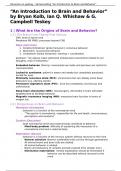Samenvatting
Samenvatting "An Introduction to Brain and Behavior" (Lesboek Hersenen en Gedrag)
- Instelling
- Tilburg University (UVT)
Dit document vat alle stof samen van het boek "An Introduction to Brain and Behavior" geschreven door Bryan Kolb, Ian Q. Whishaw en G. Campbell Teskey. Het tentamen van Hersenen en Gedrag is gebaseerd op de hoorcolleges en de stof beschreven in dit boek. De samenvatting is verkort opgeschreven (nie...
[Meer zien]




